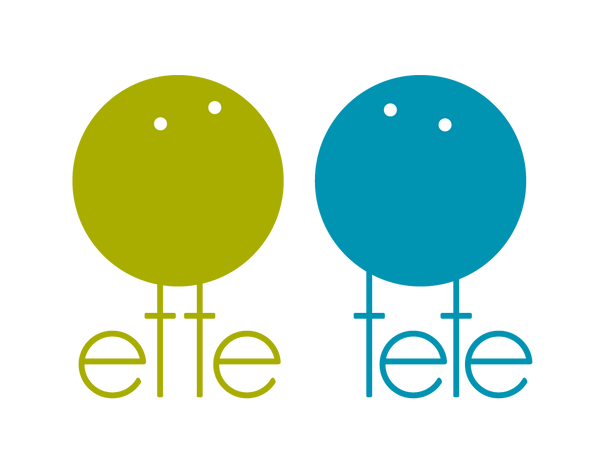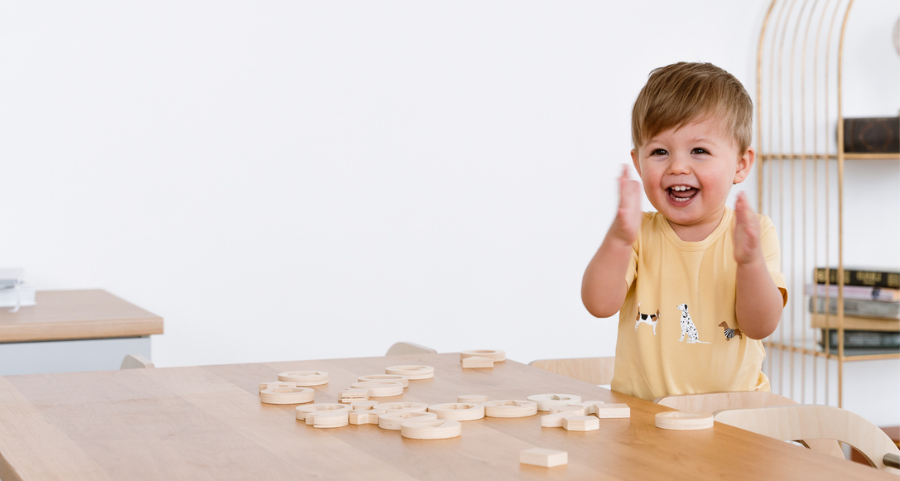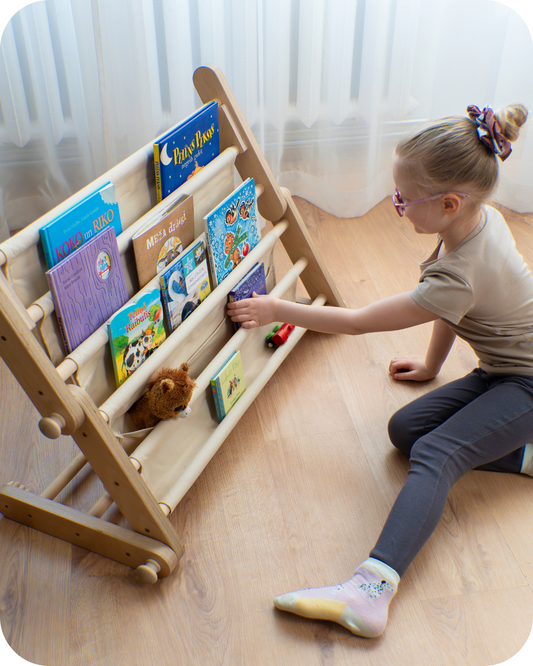Colors can have a significant impact on the way we feel. Imagine bright colors and pastel colors – each of them sets a different emotion to us. The same colors affect children. They play a large role on child's development. They can affect child's mood, behavior, and learning. Bright colors can be stimulating and energizing, while softer colors can have a calming effect.
In this blog article you will find helpful information about the impact colors make on infants and toddlers; how colors can help your toddler to better understand emotions; and how not to overstimulate children with colors.

How infants start to understand colors
Infants start to understand colors by observing and distinguishing different colors in their environment. Infants go through various stages as they start to understand colors:
Birth to 3 months: At birth, infants can only see high-contrast colors such as black, white, and gray. As their vision develops, they start to distinguish between primary colors, such as red, blue, and yellow. Infants are attracted to bright and bold colors, and may respond more to warm colors such as red and orange.
3 to 6 months: By three months of age, infants can distinguish between more subtle shades of colors, and can differentiate between colors that are similar, such as green and yellow. Infants at this stage may also be more interested in patterns and textures.
6 to 12 months: By six months of age, infants can distinguish between a wider range of colors and may be able to match objects of the same color. They may also show a preference for certain colors, such as red or blue. At this stage, infants are also beginning to explore their environment more and may be interested in toys that are brightly colored.
12 to 18 months: By 12 months of age, some infants can start to name first colors, such as "red" or "blue," although they may not yet understand the concept of color as a category. They may also begin to understand that objects can have multiple colors.
The impact of colors on toddlers
Colors can have a significant impact on toddlers, as they are still developing their cognitive and emotional skills. Bright colors can stimulate their senses and encourage exploration, while pastel colors can have a calming effect.

It's important to note that every child is unique, and may respond differently to different colors.
Emotions: Like children of any age, colors can affect a toddler's emotions and mood. Bright and warm colors such as yellow, orange, and red can promote feelings of happiness and energy, while cool colors such as blue and green can create a calming effect.
Attention and concentration: Certain colors can also affect a toddler's attention and concentration. Bright colors can be stimulating and grab a toddler's attention, while softer colors can be soothing and help them to focus.
Exploration and learning: Toddlers are in a stage of exploration and learning, and colors can play a role in this. Bright colors can encourage toddlers to explore their environment and interact with objects but can create an overstimulating effect. Different colors can be used to teach them about basic concepts such as colors, shapes, and sizes.
Personal expression: Colors can also be used as a way for toddlers to express themselves and their individuality. Encouraging toddlers to choose colors for their clothing or art projects can help them to develop a sense of personal style and creativity.
Sleep: Colors can also affect a toddler's sleep patterns. Soft, soothing colors such as blue and lavender can promote relaxation and help toddlers to fall asleep more easily.
Colors can help toddlers better understand emotions
Colors can be a valuable tool for children to understand and manage their emotions. By using different colors to represent emotions, encouraging creative expression, and using color-coded resources, children can develop a better understanding of their emotions and learn healthy ways to express and manage them. This can be a valuable tool for parents and caregivers to help toddlers better understand their emotions.

Color associations: Just like with older children and adults, toddlers can learn to associate colors with different emotions. Parents and caregivers can use this to their advantage by using different colors to represent different emotions, such as yellow for happy or red for angry. This can help toddlers to better understand and communicate their own emotions, as well as recognize the emotions of others.
Visual cues: Toddlers are highly visual learners and respond well to visual cues. Using different colors to represent different emotions can provide a visual cue that can help toddlers to understand and recognize emotions. For example, a chart or poster with different colors and corresponding emotions can help toddlers to identify and express their own feelings.
Art and creative expression: Like children of any age, toddlers can benefit from using art and creative expression to explore and understand their emotions. Providing toddlers with different colored art materials, such as crayons or paints, can help them to express their emotions in a safe and creative way.
Colorful books and media: Colorful books and media can also be a useful tool to help toddlers understand emotions. Books with bright and engaging illustrations can help toddlers to recognize and understand different emotions, while animated shows or videos with colorful characters can help them to learn about emotions in a fun and engaging way.
The wheel of emotions
Here you can download our wheel of emotions PDF file. It is a great way to help your toddler learn and understand different emotions and start to understand how certain things make them feel. It can help in the learning process of emotional regulation.
Use the wheel of emotions and WIN OUR GIFT CARD!
Print the material, spin it with your child, color it and share this process in an Instagram story mentioning us @ettetete.

Why it is important for toddler to recognize emotions
It is important for toddlers to recognize emotions because it helps them to develop important social and emotional skills that are crucial for their overall well-being and success in life.

Understanding their own emotions: By recognizing and understanding their own emotions, toddlers can develop important self-awareness skills that can help them to regulate their emotions and cope with stress and challenging situations.
Communicating their feelings: Recognizing emotions allows toddlers to communicate their feelings to others. This is important for building positive relationships with caregivers, peers, and family members, as well as for developing effective communication skills.
Empathy and perspective-taking: Recognizing emotions in others allows toddlers to develop empathy and perspective-taking skills. These skills are crucial for building positive relationships, resolving conflicts, and understanding the needs and feelings of others.
Emotional regulation: Recognizing emotions is a crucial first step in learning how to regulate them. By understanding and recognizing their own emotions, toddlers can learn healthy ways to manage and cope with strong emotions, such as taking deep breaths or talking to a caregiver.
Overall, recognizing emotions is an important developmental milestone for toddlers, as it helps them to develop important social and emotional skills that will benefit them throughout their lives.
How not to overstimulate toddler with colors
While colors can be beneficial for a child's development, it's important not to overstimulate them with too many colors. Here are some ways to avoid overstimulating a toddler with colors.

Use a limited color palette: When decorating a toddler's room or choosing clothes for them, it's important to limit the number of colors used. Too many colors can be overwhelming and overstimulating for young children. Stick to a few calming, muted colors that are easy on the eyes.
Use color in moderation: While colors can be helpful for stimulating a toddler's imagination and creativity, it's important to use them in moderation. Too much color can overstimulate and distract young children. Focus on using color in strategic ways, such as with toys or art materials, to create a visually appealing environment that's not overwhelming.
Choose calming colors: When selecting colors for a toddler's environment, choose calming and soothing colors, such as soft blues or greens, that promote relaxation and calmness.
Use natural materials: Whenever possible, choose natural materials, such as wood or cotton, over synthetic materials that can be overly stimulating for young children. Natural materials are less likely to contain bright colors or patterns that can be overwhelming.
Pay attention to your child's cues: Every child is different, so pay attention to your child's reactions to different colors and stimuli. If you notice that your child becomes overly stimulated or agitated in a certain environment, try adjusting the colors or decor to create a more calming environment.

Overall, it's important to create a calming and soothing environment for toddlers, using colors in moderation and choosing calming colors and natural materials whenever possible. By paying attention to your child's cues and adjusting the environment accordingly, you can help to avoid overstimulation and create a safe and nurturing space for your toddler to thrive in.






